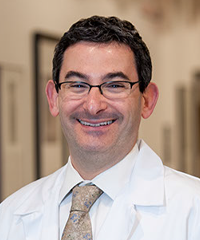Oncology
Relapsed/Refractory Diffuse Large B-Cell Lymphoma
Therapeutic Sequencing in Relapsed/Refractory Diffuse Large B-Cell Lymphoma
Overview
The expanding armamentarium for relapsed/refractory diffuse large B-cell lymphoma (R/R DLBCL) is allowing patients to have more options for treatment. Our featured experts discuss the sequencing of therapies in different patient populations.
How do you organize your approach to treating different types of patients with R/R DLBCL?
Matthew J. Matasar, MD
|
|
“We do have a broadening armamentarium of options for R/R DLBCL, so the challenge now lies in determining how to best sequence these therapies.”
The current standard of care for patients in the second-line setting who are relapsed or refractory to first-line chemoimmunotherapy is to categorize patients as being eligible or ineligible for the consideration of consolidation with autologous stem cell transplantation (autotransplant). We currently approach those who are potentially eligible in a stepwise fashion, giving second-line platinum-based chemoimmunotherapy with the intention of consolidating a partial response or better with an autotransplant. In that situation, platinum-based chemoimmunotherapy remains the standard, and the consensus is that there is no single best platinum program. We often choose between regimens such as rituximab, ifosfamide, carboplatin, and etoposide phosphate (R-ICE) and other platinum-based regimens, recognizing that no single platinum-based program has been shown to be superior to others in this setting.
Patients who are transplant ineligible represent a real clinical challenge because they often may be quite ill. One way of thinking about it is to consider whether you could imagine ever giving chimeric antigen receptor (CAR) T-cell therapy to the patient or whether you know that CAR T-cell therapy is never going to be an option for that individual, no matter what happens with their lymphoma. We do have a broadening armamentarium of options for R/R DLBCL, so the challenge now lies in determining how to best sequence these therapies. We have CD19-directed therapies, antibody-drug conjugates, and other treatments, but we currently lack high-quality data regarding the optimal way to sequence these therapies in high-risk patients.
CAR T-cell therapy has the potential to replace standard platinum-based chemoimmunotherapy in the second-line setting, as there are ongoing trials evaluating the 3 CAR T-cell regimens in R/R LBCL compared with salvage therapy followed by high-dose chemotherapy and autotransplant. Early information suggests that trials of 2 of the CAR T-cell products, axicabtagene ciloleucel and lisocabtagene maraleucel, may have met their primary event-free survival end points, but we are awaiting the full data from these and other studies.
The question then becomes: By using CAR T-cell therapy earlier in the course of care, will the natural history of the disease be altered? Will patients live longer by sequencing CAR T-cell therapy prior to other treatments of relapsed DLBCL, or are we simply getting a better response rate without leading to improved outcomes overall? The actual magnitude of a clinically meaningful impact of using CAR T-cell therapy earlier in the disease course will, in part, determine the level of uptake of this novel therapeutic approach in this setting.
Jeremy S. Abramson, MD, MMSc
|
|
“DLBCL is a potentially curable disease, even in the second- and third-line settings. Considerations that include age, fitness, comorbidities, and organ function can inform optimal treatment selection.”
DLBCL is a potentially curable disease, even in the second- and third-line settings. Considerations that include age, fitness, comorbidities, and organ function can inform optimal treatment selection.
When selecting a potentially curative-intent option at the time of first relapse, the first question is: Is the patient eligible for transplant? And then, if they achieve a complete or partial response to second-line platinum-based therapy, they would proceed to high-dose chemotherapy with autotransplant. Those who do not respond to second-line chemotherapy would proceed to third-line treatment without receiving a transplant, and this also has a curative intent. Optimal third-line treatment includes 1 of the 3 US Food and Drug Administration–approved CAR T-cell therapies: axicabtagene ciloleucel (approved in October 2017), tisagenlecleucel (approved in May 2018), and lisocabtagene maraleucel (approved in February 2021). These agents can induce durable remissions in approximately 33% to 40% of patients in the third-line, or later, setting. For patients who are not candidates for CAR T-cell therapy at that time, we would proceed to palliative-intent therapies.
A patient in relapse who is not considered to be transplant eligible would typically go to a lower-intensity strategy (eg, rituximab, gemcitabine, and oxaliplatin [R-GemOx regimen] or tafasitamab plus lenalidomide) in the second-line setting. In the third-line setting, CAR T-cell therapy may still be an option for such a patient. Many individuals who are not candidates for transplant are candidates for CAR T-cell therapy, particularly 41BB co-stimulated CAR T cells if they are older or somewhat frail, and this would still be with curative intent, despite the less intense second-line therapy. I typically would not give tafasitamab in the second line to a patient I may take to CAR T cells in the third line, since we do not presently know whether targeting CD19 in a prior line of therapy may impede the curative potential of subsequent anti-CD19 CAR T cells.
As Dr Matasar alluded to, 2 press releases have spoken to the possibility of replacing autotransplant with CAR T cells in the future. With a median follow-up of 2 years, the top-line results from the ZUMA-7 trial indicated that axicabtagene ciloleucel therapy was superior to the standard of care (ie, a platinum-based salvage combination chemotherapy regimen followed by high-dose therapy and autotransplant) in terms of event-free survival and objective response rates. The top-line results from the TRANSFORM trial with lisocabtagene maraleucel also showed an improvement in event-free survival and response rates. These studies involved patients with primary refractory disease or disease relapsing within 1 year of standard upfront chemotherapy, a group that is less likely to have durable remissions with transplantation. Survival data from both trials are immature, and we look forward to more data being presented at upcoming meetings.
Brad Kahl, MD
|
|
“Distinguishing between those who are ‘ever CAR’ or ‘never CAR’ is a very reasonable approach because it is important for patients who are candidates for CAR T-cell therapy to receive this treatment in a way that optimizes the probability of cure.”
I agree with Dr Abramson’s strategy for sequencing patients, and that is exactly how I approach patients. Distinguishing between those who are “ever CAR” or “never CAR” is a very reasonable approach because it is important for patients who are candidates for CAR T-cell therapy to receive this treatment in a way that optimizes the probability of cure.
There are, however, some theoretical considerations that one should take into account. For example, we know that bendamustine is hard on a patient’s T-cell population, and, if it is given right before a T-cell collection, it could result in a difficulty with the collection of the T cells. So, in general, we try to avoid that agent and instead use other products for disease control purposes in patients for whom CAR T-cell therapy is planned. Similarly, tafasitamab plus lenalidomide and loncastuximab tesirine, which are both CD19-directed treatments, could potentially interfere with CAR T-cell therapy. There is a theoretical concern that such treatments could cause a downregulation of CD19 expression or could produce CD19-negative escape mutants, which might decrease the effectiveness of CAR T-cell therapy.
References
Bristol Myers Squibb announces positive topline results from phase 3 TRANSFORM trial evaluating Breyanzi (lisocabtagene maraleucel) versus chemotherapy followed by stem cell transplant in second-line relapsed or refractory large B-cell lymphoma. News release. Bristol Myers Squibb. June 10, 2021. Accessed October 15, 2021. https://news.bms.com/news/details/2021/Bristol-Myers-Squibb-Announces-Positive-Topline-Results-from-Phase-3-TRANSFORM-Trial-Evaluating-Breyanzi-lisocabtagene-maraleucel-Versus-Chemotherapy-Followed-by-Stem-Cell-Transplant-in-Second-line-Relapsed-or-Refractory-Large-B-cell-Lymphoma/default.aspx
Caimi PF, Ai W, Alderuccio JP, et al. Loncastuximab tesirine in relapsed or refractory diffuse large B-cell lymphoma (LOTIS-2): a multicentre, open-label, single-arm, phase 2 trial. Lancet Oncol. 2021;22(6):790-800. doi:10.1016/S1470-2045(21)00139-X
ClinicalTrials.gov. A study to compare the efficacy and safety of JCAR017 to standard of care in adult subjects with high-risk, transplant-eligible relapsed or refractory aggressive B-cell non-Hodgkin lymphomas (TRANSFORM). Updated June 10, 2021. Accessed October 15, 2021. https://clinicaltrials.gov/ct2/show/NCT03575351
ClinicalTrials.gov. Efficacy of axicabtagene ciloleucel compared to standard of care therapy in subjects with relapsed/refractory diffuse large B cell lymphoma (ZUMA-7). Updated October 14, 2021. Accessed October 15, 2021. https://clinicaltrials.gov/ct2/show/NCT03391466
Duell J, Maddocks KJ, González-Barca E, et al. Long-term outcomes from the phase II L-MIND study of tafasitamab (MOR208) plus lenalidomide in patients with relapsed or refractory diffuse large B-cell lymphoma. Haematologica. 2021;106(9):2417-2426. doi:10.3324/haematol.2020.275958
Gauthier J, Bezerra ED, Hirayama AV, et al. Factors associated with outcomes after a second CD19-targeted CAR T-cell infusion for refractory B-cell malignancies. Blood. 2021;137(3):323-335. doi:10.1182/blood.2020006770
Kite announces Yescarta® CAR T-cell therapy improved event-free survival by 60% over chemotherapy plus stem cell transplant in second-line relapsed or refractory large B-cell lymphoma. News release. Business Wire. June 28, 2021. Accessed October 15, 2021. https://www.businesswire.com/news/home/20210628005449/en/Kite-Announces-Yescarta%C2%AE-CAR-T-cell-Therapy-Improved-Event-Free-Survival-by-60-Over-Chemotherapy-Plus-Stem-Cell-Transplant-in-Second-Line-Relapsed-or-Refractory-Large-B-cell-Lymphoma
Lekakis LJ, Moskowitz CH. The role of autologous stem cell transplantation in the treatment of diffuse large B-cell Lymphoma in the era of CAR-T cell therapy. Hemasphere. 2019;3(6):e295. doi:10.1097/HS9.0000000000000295
Sehn LH, Salles G. Diffuse large B-cell lymphoma. N Engl J Med. 2021;384(9):842-858. doi:10.1056/NEJMra2027612
Wang L, Li L-R, Young KH. New agents and regimens for diffuse large B cell lymphoma. J Hematol Oncol. 2020;13(1):175. doi:10.1186/s13045-020-01011-z













